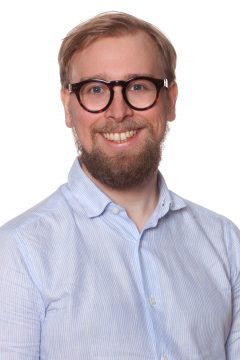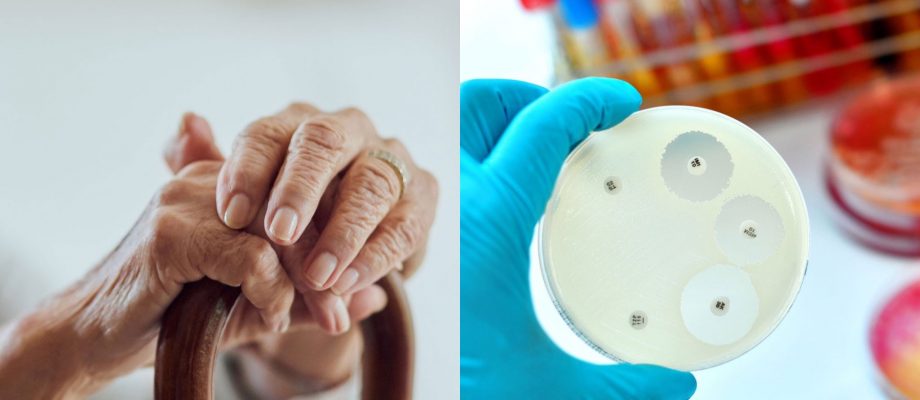AWARDS. Claes Ohlsson and Johan Bengtsson-Palme have been announced as the recipients of awards established by the Gothenburg Society of Medicine (GLS) and Sahlgrenska Academy. These awards are only given every five years.
This year’s recipient of the Grand Prize for Outstanding Medical Research from the Gothenburg Society of Medicine (GLS) and Sahlgrenska Academy is Professor Claes Ohlsson at the Institute of Medicine and chief physician in clinical pharmacology at Sahlgrenska University Hospital. He is receiving the award for his epoch-making scientific discoveries in the field of osteoporosis, where he is an internationally leading researcher.
Shared honor
Claes Ohlsson is part of a productive research environment, which has demonstrated that hormones, genes and intestinal bacteria affect bone mass. These findings increase our understanding of why some people are more likely to suffer a fracture. Although the award is given to him personally, he feels the honor belongs to all of his colleagues who have contributed to osteoporosis research in Gothenburg.

“It’s really wonderful that our research has been recognized with this amazing award. We have seen enormous advancements over the last 20 years, and there are now a number of successful senior researchers engaged in unique osteoporosis research, ranging from basic research on bone metabolism to clinical treatment studies,” says Claes Ohlsson, who is currently working with a coming article on a new and exciting risk factor for hip fractures.
More effective and safer treatments
Claes Ohlsson leads research on individualized osteoporosis treatment, which can lead to more effective, safer and individualized treatments for sufferers of osteoporosis.
“We work to identify markers that can determine whether an individual has a high risk of suffering a bone fracture. Namely, patients who are most at risk of suffering a future fracture have the greatest benefit from osteoporosis drugs.”
Artificial intelligence
His current project will be carried out with large-scale analysis methods in well-characterized patient material and support from machine learning to find the markers that can best be used to determine the risk a patient has for suffering a certain type of fracture. Understanding the different markers to be identified will also allow identifying new drug targets.
“Our preliminary studies indicate that there are different mechanisms involved in different fracture types. We will investigate these mechanisms for how some of our most promising, recently identified proteins affect fracture risk.”
A wholistic approach to health
The Award for Younger Researchers from the Gothenburg Society of Medicine and Sahlgrenska Academy goes to doctoral research fellow Johan Bengtsson-Palme at the Institute of Biomedicine. He leads a relatively newly established team looking at the effects of antibiotics on bacteria, including antibiotic resistance.

“In general, it has been a tough year for most of us, and having our research recognized in this way is incredible after a year that has been very tiresome in so many ways,” says Johan Bengtsson-Palme.
He is positive to the fact that GLS and Sahlgrenska Academy are recognizing both the basic view known as One Health, which includes the health of both people and animals, and the environment we live in.
“Much of what we have done in my team is primarily about how antibiotic-resistant bacteria develop in animal husbandry and in the environment, even though we constantly have the risks to human health as our lodestar. It is wonderful to really feel that we have done research that is medically important and relevant.”
Setting up model systems
The team is working on setting up a number of model systems to identify which genes are important for how different bacteria integrate with each other, for example, in the human gastrointestinal system.
“Eventually, we want to be able to see how antibiotics manipulate these relationships between microbes, but to get there we must first find the model systems to play with, and we have learned the hard way that it takes time.”
Genes that increase resistance
One track that the group has recently begun to work on is the link between genes that contribute to increased ability to colonize in the presence of other bacteria and the genes that increase tolerance to antibiotics in the opportunistic pathogen Pseudomonas aeruginosa.
“We have found a bunch of genes that both increase resistance to antibiotics and that also seem to be involved in competing with other bacteria and colonizing new niches. To bring this all together, we now want to see if we can trigger these genes that make Pseudomonas aeruginosa more aggressive with the help of antibiotics, and study how strong the link actually is between antibiotic exposure, increased colonization and, in the long run, virulence. But we have a bit left here before we are ready to publish.”
On campus and distance
Currently, the biggest challenge for the group is the spread of COVID-19. The pandemic has, among other things, led to a doctoral student from the United States having to decline his position.
“Since we do not really know where this will go in the coming months, it is difficult to plan and structure, especially since we are such a new research team. We had barely had time to get our routines in place before the pandemic broke out. But an advantage of not having set routines has been that we have been able to choose communication tools and working methods that work well both on site and at a distance.
The award ceremony will take place in connection with the Gothenburg Society of Medicine’s closing meeting on December 2, where the two recipients will give presentations.
TEXT: ELIN LINDSTRÖM











